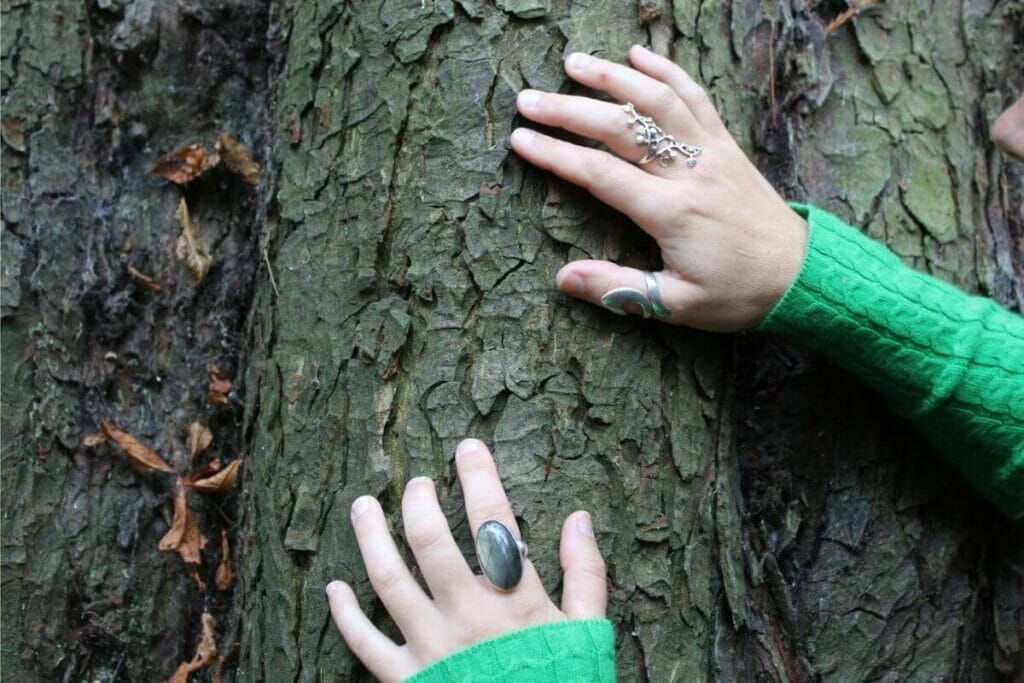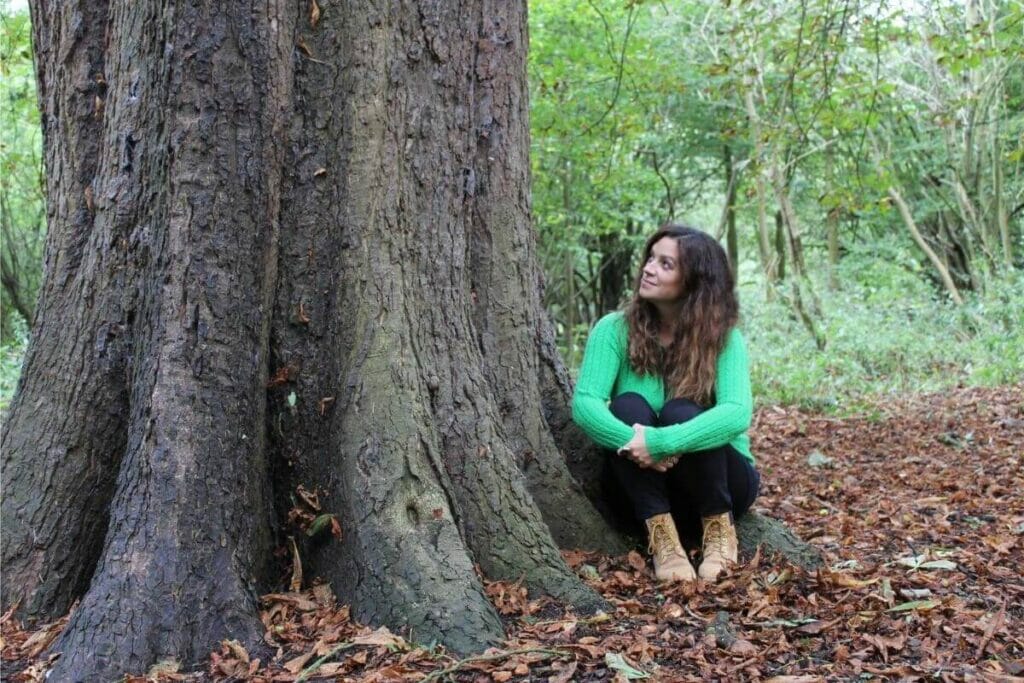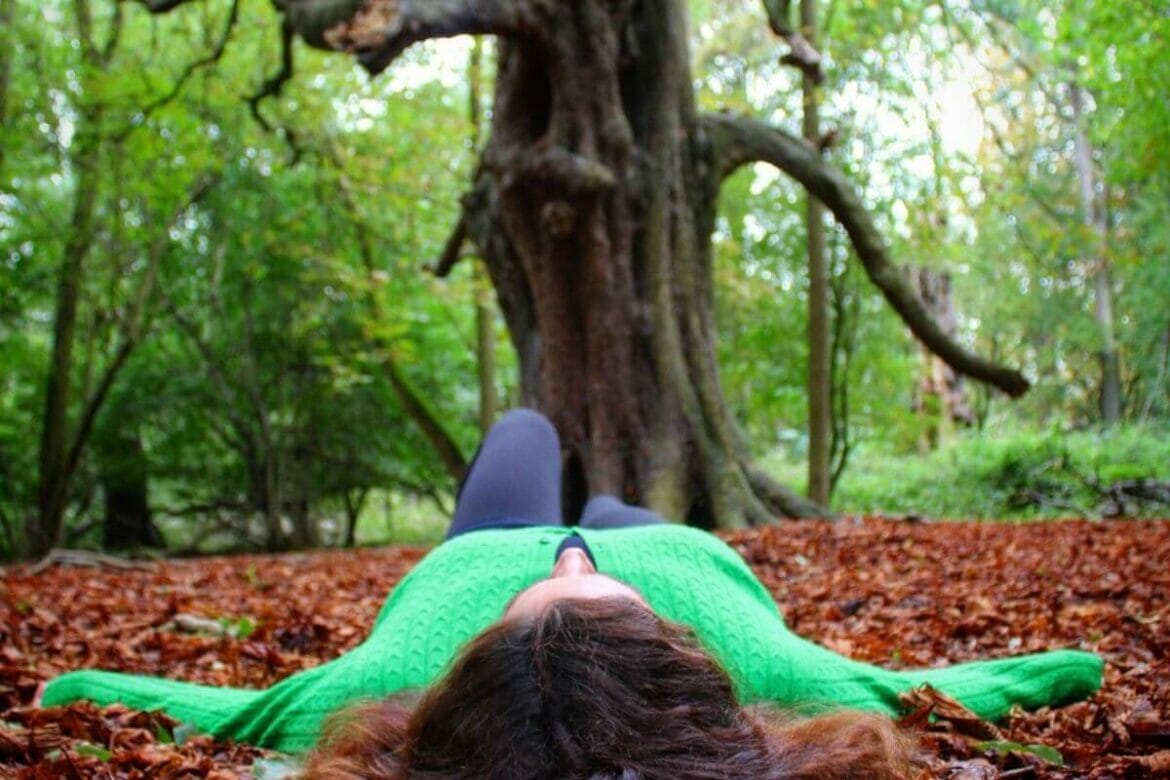Ruth stumbled into the practice of Forest bathing, and life was never the same for her again!
Hospitalised for a long time after a respiratory illness, Ruth knew she had a long way to recover and that it would not be an easy one. She had no choice but to return to her parents, who lived in Essex, a county in the UK with patches of woods nearby. Her slow, nature walks into the woods brought her senses back to life, and she knew the woods had the power to repair and rejuvenate.

After embarking upon training, Ruth began guiding people in Forest bathing. For those who wonder what it is, Ruth explains about it in this article. Though Forest bathing sounds somewhat slow, Ruth sounds quite vibrant, lively, and lovely!
Our questions and Ruth’s answers for you…
1. What is Forest bathing?
“Shinrin-Yoku” or forest bathing is the practice of spending time in the forest for better health, happiness, and a sense of calm. It literally means to bathe in the atmosphere of the forest, immersing your senses in your surroundings. No swimsuits or water required! Also, it is not a hike, and there is no goal. Just discovery, curiosity, awareness, openness, awe and joy!
A preventative medicine since the 1980s, the Japanese Forest Agency suggested the practice as a way to reconnect with nature and calm stressed-out city dwellers. It’s a slow sensory walk through the forest using mindfulness, meditation, breathing, and walking exercises.
Your guide will invite you to participate in various activities and exercises all designed to awaken your natural senses and slow down your mind, to bring your awareness to the here and now deep within nature.
Relaxing, connecting, stimulating, refreshing, immersing, and awakening to our natural roots, you get connected to nature. Forest bathing will remind you that you are part of something bigger; you are part of the natural world. You are nature.
Learn more about Forest bathing in this video:
2. Why should I try it?
Well, there are no “shoulds” in forest bathing, so it’s absolutely up to you. But I would say it’s a very accessible form of mindfulness, enabling you to connect to nature and connect to yourself.
Anyone can do it; there is no required belief system or experience needed. There are no expectations on how you should feel, and there is no need to achieve anything by the end of a session. It is simply YOUR time to spend in nature. And you can take away any of the ideas and exercises to use in your own time when next out in nature.
Many people say that it gave them a chance to relax and get some actual time out and also allowed them to see nature differently or more deeply. For many participants, it has truly transformed their relationship with nature and stays with them forever.

Plus, you don’t need to attend a whole series of sessions or sign up for any sort of commitment. Instead, you can participate in one forest bathing session and take your experience from there. That said, many people do return again and again as they enjoy it so much.
However, you must also be aware that Shinrin Yoku and Mindfulness exercises are not replacements or alternatives to professional medical help for physical or mental health. They are practices that instead offer tactics and skills that may help you whilst managing your health and wellness and may provide some space and calm amongst the stress and worries.
Also Read: 5 Important Things To Know Before Your First Yoga Class
3. Is it for everyone, or is there any group of people who should not do it?
While it is most certainly for anyone who would like to attend, it is worth noting that nature can be daunting or even scary for some people.
Depending on your experiences, feelings, traumas, and triggers, nature can provide a deep rest from such challenges in your life. However, for some, it can actually be triggering trauma if they are uncomfortable in the forest or green spaces.
Hence, it is important to recognise this and only choose what you are comfortable with. There is no one set course for anyone. We each are different and may have different things work for us. No problem there, you can find your safe choice.
If you have any concerns, it may be worth talking them through a medical or mental health professional before attending. Your guide should also ask you to let them know if you have any concerns or needs for additional support so you can talk through what is suitable for you.
4. Can children do forest bathing?
Absolutely! And most children are probably very natural forest bathers, immersing themselves at the moment and getting stuck into nature! So look for guides that offer children’s sessions, or also look into forest schools which often provide some forest bathing within their activities.
Also Read: Forest Bathing/Shinrin Yoku: Discover What It Is With This Good Read
5. How do I prepare myself for my forest bathing session?
Be sure to bring comfortable clothes that you don’t mind getting dirty (if you choose to sit or lie on the ground).
Layers are a good idea, remembering that you may be walking slowly or standing/sitting still for long periods of time and therefore may feel colder than if walking at your normal pace.

Waterproofs are good too when we forest bathe in the rain and it is a wonderful experience!
Bring plenty of water and snacks if you need them, and try to travel as light as possible so that you can let go of any other worries for the time that you are in the forest.
6. How long is a typical forest bathing session?
Usually between 2 and 3 hours, which might feel like a long amount of time before you attend! But most participants say they don’t notice the time pass. They don’t feel rushed, yet they don’t see it being hours later when the session ends! Time passes differently when we are present in nature.
7. What can I expect during the session?
Your guide will offer you a series of exercises through invitations, and they are just that: invitations! Everything is optional. If you don’t feel comfortable or something doesn’t resonate for you that day, you can always sit by a tree and take some time just for yourself.
Invitations will invite you to connect to nature through exploring the senses, such as
- noticing what you can see, smell, hear, touch
- walking barefoot
- taking some time to make some forest art
Invitations can vary on the day, the group, the location, the weather and the guide. So, no two sessions are ever the same. This is the joy of nature and our time with it.
8. How often should I do it?
As often as you wish! There is no set “prescription” here, although you will find many articles that quote research that says one session will give benefits for up to 30 days.
However, I am always hesitant on how to communicate this because surely it is your choice. Equally, the more you do it, the more benefits you will most likely feel.
Besides, you do not need to go with a group to forest bathe. You can do it alone or with a friend. But of course, the benefits of going with a trained Shinrin-Yoku guide are that you can truly switch off from your phone and worries. A guide can keep an eye on the time and the path whilst also giving you ideas and suggestions, thus facilitating a deeper connection.
You Might Also Like: 6 Practical Tips For Yoga Practice At Home
9. Since this activity involves being outdoors, I am scared of insects, snakes, etc. What can I do?
Firstly, be kind to yourself, this is absolutely ok and very normal. Talk to your guide about your worries.
Your guide would have done a risk assessment for the location they are guiding you in. Also, they would be first aid trained, although they will most likely never need it as forest bathing is a very safe activity.

Locations are usually chosen based on safety and ease. Still, of course, being in nature, we are working with wildlife and within wildlife’s territory. Your guide will show you what to do should you encounter any snake or insect or living thing that worries you. In fact, you may find that once you begin to connect with nature in this way during a session that your fears transform a little.
I myself am quite scared of spiders; I used to be incredibly phobic. But as I step into a calmer headspace, connecting and observing nature with joy and curiosity, I am able to meet a spider in the wild and enjoy observing it without fear.
Something happens within me that allows me to just be and watch, knowing and trusting that I am safe.
Also, my own movements are slower, as we are not “hiking” or walking at a normal pace, so I am not a threat to the living things around me. Therefore, I am less likely to surprise anything, such as a snake on a path. You will see your interactions with creatures in the wild actually transform!
Things are slower and calmer and allow space to see the beauty in all things. I’m not saying you will conquer your fears, but you may discover a different way to sit with them.
You Might Also Like:
10. How do I find a guide for forest bathing?
There are more and more guides around the world now. You can do a quick search online and find one nearby.
Also, it’s worth checking out their credentials, such as checking if they are insured and first aid trained, as this shows they have integrity and are responsible for taking care of their participants.
Besides, there are a few larger forest bathing organisations around training guides now, such as the ANFT, GIFT, and FTI. I chose to train with a CPD (UK) recognised course and trained in other related disciplines such as Mindfulness teacher training at a reputable college in the UK.
11. I am unable to find a guide in my locality. What should I do?
You may find some retreats you can attend or travel to, or you could contact an organisation such as the ANFT to ask them if someone might be willing to travel to host some sessions. Or, of course, you could even train yourself to be one! 🙂
12. What would be my takeaway after a forest bathing session?
I don’t like to say that you will feel any certain way or that you should take away anything specific.
But many participants talk about a whole new connection with nature, a new way of seeing nature. Also, many experience a deep sense of calm and often sleep really well later that day!
Others just really enjoy having given themselves a few hours of really switching off and time away from stresses and strains of daily life.

One other concept I try to invite participants to consider and ponder in their own time is our relationship with nature; that we are nature and part of nature, but not the masters of nature.
It is a reciprocal relationship, and therefore we must consider what we give to the non-human world and how we protect it. And, of course as once we connect to something, we are moved to protect it.
And so, my hope is that the more people who begin to reconnect with non-human beings, the more we can work towards living sustainably within it.
13. What would be your advice to newbie forest bathers?
Just give it a try! Let go of expectations or need to achieve anything. Allow yourself just to be curious. Enjoy the curiosity!
14. Could you please provide real-life examples where forest bathing has immensely benefited the person?
There are countless examples in books and scientific research that show time in nature is beneficial to us in many ways. In addition, testimonies and reviews of forest bathing participants abound on various forest bathing websites and blogs.
For me, I particularly enjoy listening to participants at the end of the session, sharing how the experience has benefited them. But what I would share here is my own story about managing PTSD symptoms. Forest bathing has allowed me space and time to find peace and rest from my symptoms, allow my attention and focus to settle, and let my nervous system rest for a while as I feel supported by nature.
You can read more about my story here https://www.forestcloudsnaturetherapy.co.uk/about-me.html
Take a survey:
Edited by love4wellness | Images: Ruth

